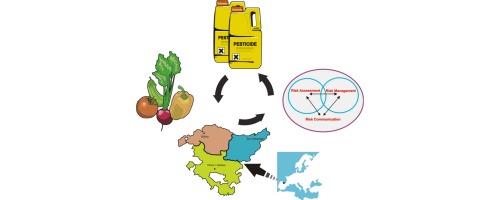Risk assessment of exposure to pesticides through dietary intake of vegetables typical of the Mediterranean diet in the Basque Country |
| |
| Affiliation: | 1. Department of Plant Health, Neiker-Tecnalia Research Institute, E-01080, Vitoria-Gasteiz, Spain;2. Departament of Analytical Chemistry, Faculty of Pharmacy, University of the Basque Country (UPV/EHU), 01006, Vitoria-Gasteiz, Spain;3. Central Service of Analysis, SGIker, University of the Basque Country (UPV/EHU), 01006 Vitoria-Gasteiz, Spain;4. ELIKA, Basque Foundation for Agrofood Safety. Granja Modelo, s/n. 01192, Arkaute (Álava), Spain;1. Laboratory of Toxicology, Department of Pharmaceutical Sciences, University of Brasilia, Brasilia, DF, Brazil;2. National Institute for Public Health and the Environment (RIVM), Bilthoven, The Netherlands;1. Faculty of Chemistry, University of Belgrade, Studentski trg 12-16, 11000 Belgrade, Republic of Serbia;2. Faculty of Science and Mathematics, University of Niš, Višegradska 33, 18000 Niš, Republic of Serbia;3. Department of Pharmacology, Clinical Pharmacology and Toxicology, Faculty of Medicine, University of Belgrade, 11000 Belgrade, Republic of Serbia;1. Department of Chemistry, University of Crete, Foundation for Research and Technology-Hellas, FORTH-IESL, GR-71003, Heraklion, Crete, Greece;2. Laboratory of Toxicology, Medical School, University of Crete, GR-71003, Heraklion, Crete, Greece;3. Department of Occupational and Environmental Health of the University of Milan, International Centre for Rural Health of the University Hospital San Paolo, S. Paolo Hospital Unit, Via San Vigilio 43, 20142 Milan, Italy;4. Environmental Engineering Laboratory, Department of Chemical Engineering, Aristotle University of Thessaloniki, Greece;5. HERACLES Research Centre on the Exposome and Health, Centre for Interdisciplinary Research and Innovation (KEDEK), Aristotle University of Thessaloniki, Greece;6. Environmental Health Engineering, Institute for Advanced Study IUSS, Pavia, Italy;1. Institute of Plant Protection – National Research Institute, Laboratory of Pesticide Residues, Chelmonskiego 22, 15-195 Bialystok, Poland;2. Kazakh National Agrarian University, Department of Veterinary Sanitary Examination and Hygiene, Abaya 8, 050010 Almaty, Kazakhstan;3. Kostanay State University A. Baitursynov, Department of Veterinary Sanitary Examination and Hygiene, A. Baitursynova 47, 110000 Kostanay, Kazakhstan |
| |
| Abstract: | 
This study examined estimated dietary exposure among the Basque Country Autonomous Community (northern Spain) to pesticides resulting from dietary intake of unprocessed vegetables. Samples were collected according to a sampling plan established previously, which was performed taking into account statistical factors, such as the population distribution, the point of sale, (local shops or supermarkets), the season and the consumption frequency of each vegetable. A total of 221 samples were analyzed using gas chromatography tandem mass spectrometry (GC–MS/MS), and liquid chromatography tandem mass spectrometry (LC–MS/MS). Results showed that 48.0% of the samples contained no pesticide residues, while 52.0% contained pesticides, and 6.8% of all samples showed residues above the maximum residue limit (MRL). As for the pesticides detected, 56 different active substances were detected, including fungicides and insecticides as the main pesticide types. All of the positive samples were collected in local-area shops. The potential risk to the consumers through vegetable intake was estimated by calculating the Hazard Quotient (HQ), showing ranges between 0.001–0.214%. These results indicate that the exposure to pesticides from vegetable intake among Basque consumers did not raise health concerns. |
| |
| Keywords: | Pesticides Maximum residue limits Vegetables Risk assessment Dietary intake Food safety Food chain contamination Food analysis Food composition |
| 本文献已被 ScienceDirect 等数据库收录! |
|

